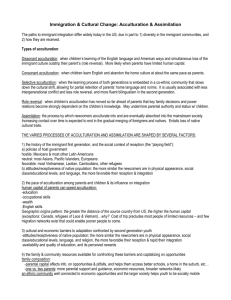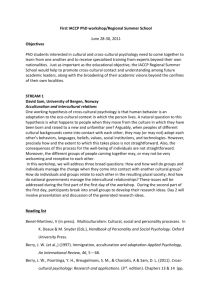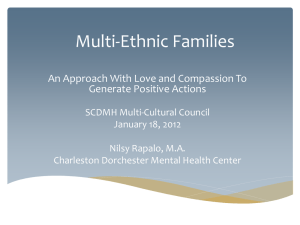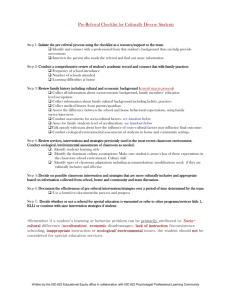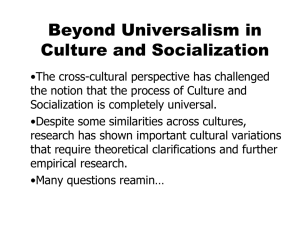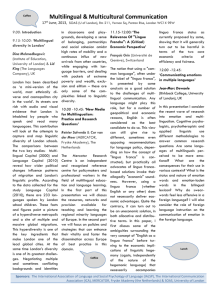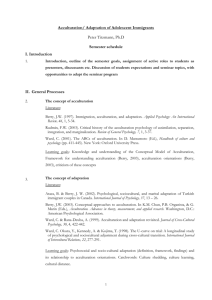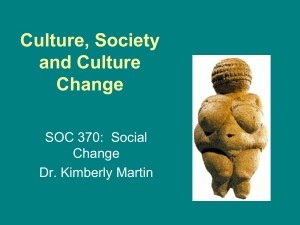readinglistacculturationstreamfinal
advertisement
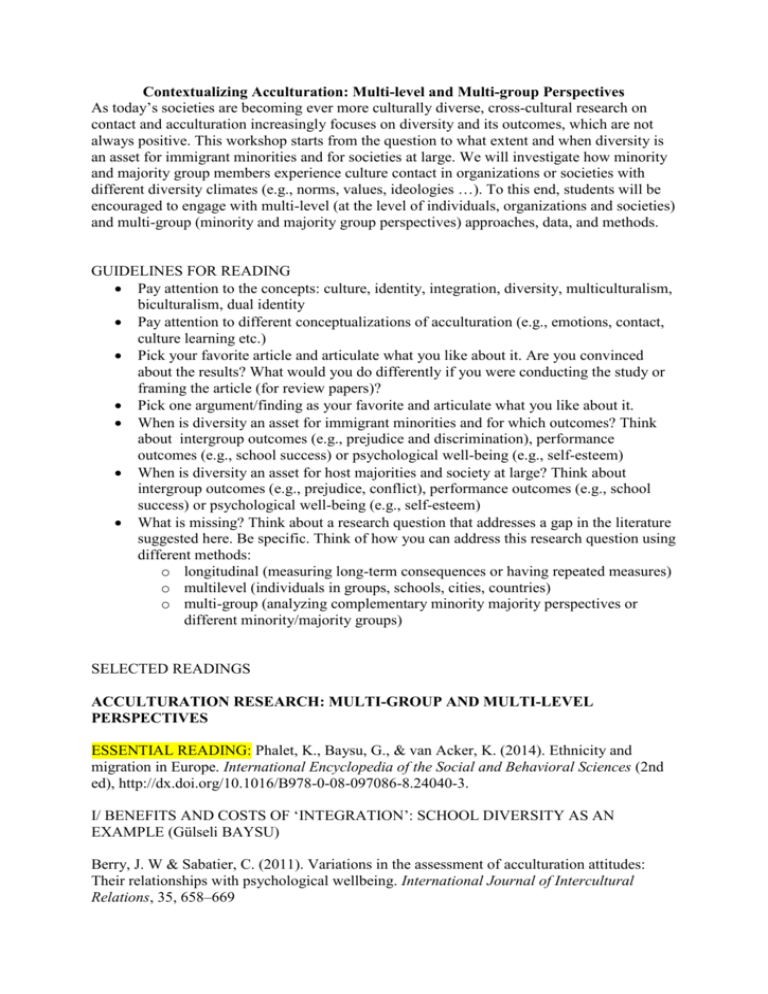
Contextualizing Acculturation: Multi-level and Multi-group Perspectives As today’s societies are becoming ever more culturally diverse, cross-cultural research on contact and acculturation increasingly focuses on diversity and its outcomes, which are not always positive. This workshop starts from the question to what extent and when diversity is an asset for immigrant minorities and for societies at large. We will investigate how minority and majority group members experience culture contact in organizations or societies with different diversity climates (e.g., norms, values, ideologies …). To this end, students will be encouraged to engage with multi-level (at the level of individuals, organizations and societies) and multi-group (minority and majority group perspectives) approaches, data, and methods. GUIDELINES FOR READING Pay attention to the concepts: culture, identity, integration, diversity, multiculturalism, biculturalism, dual identity Pay attention to different conceptualizations of acculturation (e.g., emotions, contact, culture learning etc.) Pick your favorite article and articulate what you like about it. Are you convinced about the results? What would you do differently if you were conducting the study or framing the article (for review papers)? Pick one argument/finding as your favorite and articulate what you like about it. When is diversity an asset for immigrant minorities and for which outcomes? Think about intergroup outcomes (e.g., prejudice and discrimination), performance outcomes (e.g., school success) or psychological well-being (e.g., self-esteem) When is diversity an asset for host majorities and society at large? Think about intergroup outcomes (e.g., prejudice, conflict), performance outcomes (e.g., school success) or psychological well-being (e.g., self-esteem) What is missing? Think about a research question that addresses a gap in the literature suggested here. Be specific. Think of how you can address this research question using different methods: o longitudinal (measuring long-term consequences or having repeated measures) o multilevel (individuals in groups, schools, cities, countries) o multi-group (analyzing complementary minority majority perspectives or different minority/majority groups) SELECTED READINGS ACCULTURATION RESEARCH: MULTI-GROUP AND MULTI-LEVEL PERSPECTIVES ESSENTIAL READING: Phalet, K., Baysu, G., & van Acker, K. (2014). Ethnicity and migration in Europe. International Encyclopedia of the Social and Behavioral Sciences (2nd ed), http://dx.doi.org/10.1016/B978-0-08-097086-8.24040-3. I/ BENEFITS AND COSTS OF ‘INTEGRATION’: SCHOOL DIVERSITY AS AN EXAMPLE (Gülseli BAYSU) Berry, J. W & Sabatier, C. (2011). Variations in the assessment of acculturation attitudes: Their relationships with psychological wellbeing. International Journal of Intercultural Relations, 35, 658–669 ESSENTIAL READING: Nguyen, A.M., & Benet-Martínez, V. (2013). Biculturalism and adjustment: A meta-analysis. Journal of Cross-Cultural Psychology, 44, 122-159. Brown, R., Baysu, G., Nigbur, D., Rutland, A., Watters, C., Cameron, L., Hossain, R., LeTouze, D., & Landau, A. (2013). Acculturation attitudes and social adjustment in ethnic minority British children: a longitudinal study. Personality and Social Psychology Bulletin, 39(12), 1656-1667 Baysu, G., Phalet, K., & Brown, R. (2011). ‘Dual’ Identity as a two edged sword: Identity threat and minority school performance. Social Psychology Quarterly, 74(2): 121-143. Wolfgramm, C., Morf, C. C. & Hannover, B. (2014). Ethnically based rejection sensitivity and academic achievement: The danger of retracting into one’s heritage culture. European Journal of Social Psychology. DOI: 10.1002/ejsp.2018 II/ WHEN IS CULTURAL DIVERSITY (NOT) DIVISIVE? ISLAM IN EUROPE AS AN EXAMPLE (Karen PHALET) ESSENTIAL READING Verkuyten, M. & Martinovic, B. (2012). Immigrants’ National Identification: Meanings, Determinants, and Consequences. Social Issues and Policy Review, 6(1), 82–112 Hopkins, N. (2011). Dual Identities and Their Recognition: Minority Group Members’ Perspectives. Political Psychology, 32 (2), 251-270. Güngör, D., Fleischmann, F., Maliepaard, M. & Phalet, K. (2014). Religious acculturation. European Psychologist. Special Issue on Multiculturalism (Editors: David Sam & John Berry) Fleischmann, F., Phalet, K., & Klein, O (2011) Religious identification and politicization in the face of discrimination: Support for political Islam and political action among the Turkish and Moroccan second generation in Europe. British Journal of Social Psychology (2011), 50, 628–648 STATE OF THE ART IN ACCULTURATION RESEARCH: NEW DIRECTIONS I/ COGNITIVE & AFFECTIVE ACCULTURATION: FROM ATTITUDES TO PROCESSES ESSENTIAL READING: Crisp, R. J. & Turner, R. N. (2011). Cognitive adaptation to the experience of social and cultural diversity. Psychological Bulletin, 137, 242-266 Hong, Y., Morris, M., Chiu, C., & Benet-Martínez, V. (2000). Multicultural minds: A dynamic constructivist approach to culture and cognition. American Psychologist, 55, 709720. De Leersnyder, Jozefien, Mesquita, Batja & Kim, Heejung S. (2011). Where Do My Emotions Belong? A Study of Immigrants' Emotional Acculturation. Personality and Social Psychology Bulletin 37: 451 II/ INDIVIDUALS, GROUPS, SOCIETIES: ACCULTURATION IN CONTEXT ESSENTIAL READING : Brown, R., Zagefka, H., 2011. The dynamics of acculturation: an intergroup perspective. Advances in Experimental Social Psychology 44, 129–184. Van Acker, K., Deleersnyder, J., Mesquita, B., & Phalet, K. (2014). Do “They” Threaten “Us” or Do “We” Disrespect “Them”: Majority Perceptions of Intergroup Relations and Everyday Contacts with Immigrant Minorities Group Processes and Intergroup Relations Schlueter, E., Meuleman, B. & Davidov, E. (2013). Immigrant Integration policies and perceived Group Threat: A Multilevel Study of 27 Western and Eastern European Countries. Social Science Research 42, 670–682. Guimond, S. et al (2013). Diversity Policy, Social Dominance, and Intergroup Relations: Predicting Prejudice in Changing Social and Political Contexts. Journal of Personality and Social Psychology, 104 (6), 941–958. III/ APPLIED IMPLICATIONS: MANAGING CULTURAL DIVERSITY ESSENTIAL READING : Plaut, V. C. (2002). Cultural models of diversity: The psychology of difference and inclusion. In R. Shweder, M. Minow, & H. R. Markus (Eds.), Engaging cultural differences: The multicultural challenge in liberal democracies (pp. 365-395). New York: Russell Sage Foundation Press. Plaut, V. C., Thomas, K. M & Goren, M. J. (2009). Is Multiculturalism or Color Blindness Better for Minorities. Psychological Science, 20(4), 444-446. Meeussen et al (2014). Managing diversity: How leaders’ multiculturalism and colorblindness affect work group functioning . Group Processes and Intergroup Relations.

